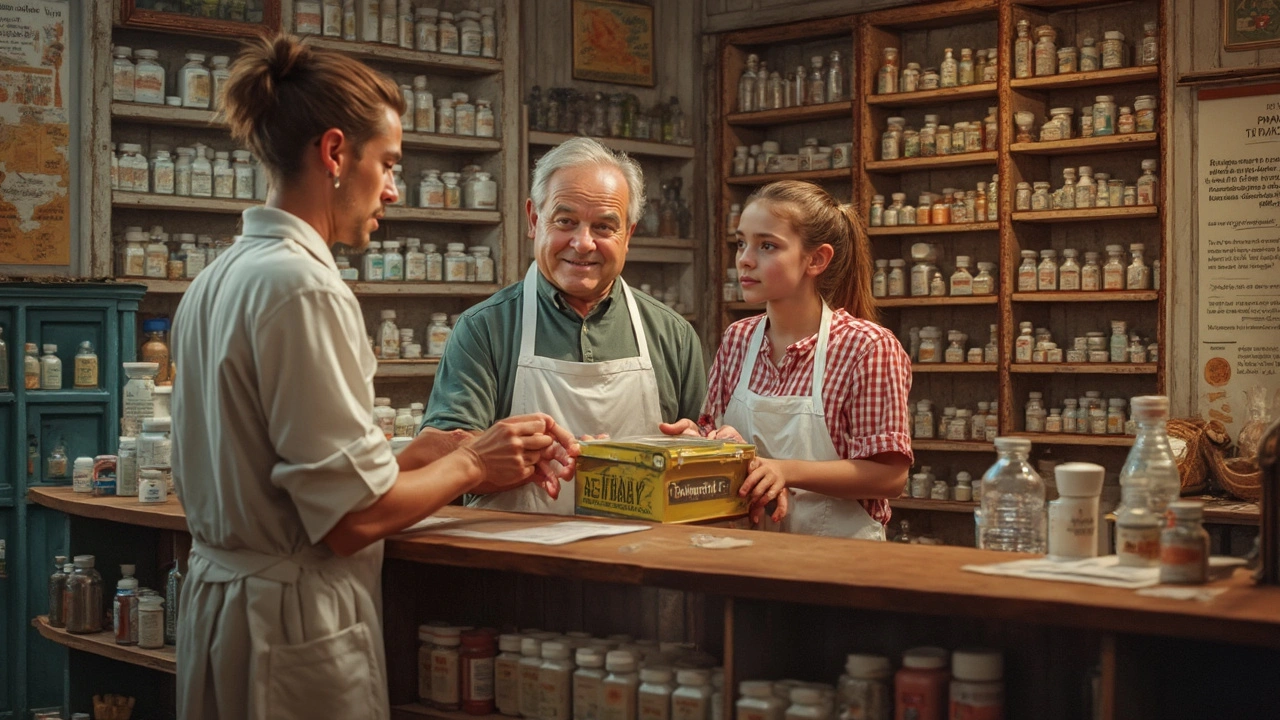How to Dispose of Unused Cefdinir Safely and Responsibly

Got some unused cefdinir just sitting in your medicine cabinet? You might think it's harmless until you need it out of your way. But simply tossing it in the trash or flushing it down the toilet without a second thought is a no-go. Why? Because improper disposal can harm the environment and even pose risks to your community's health.
So, what's the game plan? First off, don't flush it. While this might seem like an easy fix, pharmaceuticals can leach into the water system, impacting wildlife and possibly coming back to haunt us in the drinking water supply. We don't want that, do we?
A better approach is finding a drug take-back program—we'll dive into those in a bit. The key is to handle cefdinir, and other medications, as if you're dealing with something potentially hazardous. It deserves that level of attention.
- Why Proper Disposal Matters
- Safe Disposal Methods
- Risks of Incorrect Disposal
- Participating in Take-Back Programs
Why Proper Disposal Matters
You might think that popping unused cefdinir into the trash is no big deal, but it actually is. Improper disposal of medications isn't just your personal concern—it's a community and environmental issue too.
When medicines like cefdinir end up in the trash, they can leak into landfills and make their way into the soil and water. This contamination can affect wildlife and ecosystems in unexpected and harmful ways. We're talking about possible risks to aquatic life when these substances reach rivers and lakes.
Impact on Human Health
Believe it or not, traces of improperly disposed medicines can also come back to us in drinking water. Yes, a few studies have found low concentrations of pharmaceuticals in water supplies. While we're not chugging antibiotics straight from the tap, it's not exactly reassuring!
Preventing Misuse
Another vital reason to get rid of unused meds properly is to prevent accidental consumption, especially by kids or pets. You definitely don't want your curious toddler or your not-so-bright retriever ingesting something that could harm them. There's also the risk of medication misuse if drugs are diverted for recreational use.
So, what's the takeaway? Think of safe disposal as another layer of responsibility. It's not just about clearing out your cabinets, it's about taking action to prevent potential harm to both the environment and people around us.
| Category | Impact |
|---|---|
| Environmental | Water contamination, harm to wildlife |
| Health | Potential exposure through water, accidental ingestion, misuse |
Safe Disposal Methods
When you're looking to get rid of unused cefdinir, you want to do it the right way. The first thing is to check out if there are any drug take-back programs available in your area. These programs are the absolute best option—they're often run by local pharmacies, community groups, or even law enforcement.
Step-by-step: Participate in a Drug Take-Back Program
- Locate a take-back location: Check online resources like the FDA website or DEA National Take-Back Initiative. They'll point you to collection sites.
- Package your medication: Keep the medication in its original container and remove any personal information from the label.
- Drop it off: Take your meds to the collection site, where they'll handle the rest safely.
Can't find a take-back program nearby? Don't sweat. You can still dispose of unused medicine properly at home.
How to Dispose of Cefdinir at Home
This method keeps both people and critters safe. Just follow these easy steps:
- Mix meds with stuff like dirt, cat litter, or even used coffee grounds. This makes it less appealing to kids and pets—trust us, they won’t touch it.
- Seal the mixture in a plastic bag. You don’t want it leaking or spilling everywhere.
- Toss the bag in your household trash. Since you've made it unpalatable, it's a safe bet.
Avoid putting your personal info at risk. Remove your name, address, and prescription number from the bottle before recycling it. Safety first!
These methods not only protect people but also keep harmful substances from seeping into our environment. It's a win-win situation!

Risks of Incorrect Disposal
Throwing away unused cefdinir carelessly might seem harmless, but it brings a bunch of potential problems. Picture this—medications tossed in the trash can end up in landfills. Eventually, these chemicals might seep into the ground and eek into water sources. That means our drinking water could have traces of medicines that weren’t meant to be there.
It’s not just about you or the environment. When antibiotics like cefdinir get into waterways, they can mess up ecosystems. Aquatic life exposed to these substances might face serious health issues. Ever thought about fish on meds? Probably not a good idea.
Impact on Health and Safety
Improper disposal isn’t just an environmental issue; it’s also a health concern. If unused cefdinir or other antibiotics are left lying around, there's a risk they might be mistakenly consumed by others. Kids or pets could accidentally ingest them, which is definitely not safe.
There’s also a scary thing called antibiotic resistance. When antibiotics flood the environment, they can promote the growth of bacteria that resist treatment. You know what that means? It makes future bacterial infections tougher to tackle with the usual meds.
Data on Pharmaceutical Contamination
Surprisingly, a study by the US Geological Survey found that a whopping 80% of sampled waterways contained pharmaceuticals, including some common antibiotics. Here’s a quick glance:
| Finding | Percentage |
|---|---|
| Waterways Contaminated | 80% |
| Detected Pharmaceuticals | Over 50 types |
These stats drive home the point that disposing of medications responsibly is a must—not just a nice-to-have. Handling safe medication disposal properly protects our world and community from unintended consequences.
Participating in Take-Back Programs
Wondering what to do with your leftover unused cefdinir? Drug take-back programs are hands-down the safest way to dispose of them. These programs are often run by local pharmacies, police stations, or community organizations, and they're specifically set up to handle unwanted medications responsibly.
The Why and How
Why are these programs the best option? Well, they prevent medications from ending up in landfills or water supplies, which can cause harm to the environment and wildlife. Plus, they ensure drugs don't get into the wrong hands, which is a safety win for everyone.
Here's how to get involved:
- Check your local pharmacy or government websites for take-back events. These are often scheduled around specific dates like National Prescription Drug Take Back Day.
- Gather all your unused medicines, making sure they're in their original packaging if possible. It'll help the folks running the program to organize and process them more easily.
- Drop them off at the specified location. Sometimes there are drop-off boxes available, too, in case you can't make a specific event.
Other Considerations
If you can't find a local event, contact your pharmacy. Many offer ongoing take-back options or can point you in the right direction. Just make sure not to hang on to those old meds - better safe than sorry.
Participating in these programs isn't just about decluttering your cabinets. It's about doing what's right for your family and the environment. Millions of medications go unused every year, and getting rid of unused medicine correctly helps minimize negative environmental impact. It's a small step with a big impact.

Henry Seaton
February 24, 2025 AT 23:00Throwing meds in the trash is just lazy and harmful.
Baby Thingie
February 24, 2025 AT 23:01While your intent is commendable, proper disposal requires adherence to established guidelines 😊.
Abby Elizabeth
February 24, 2025 AT 23:03OMG I can't believe people still think dumping antibiotics is ok lol. It's like, u know, a total nightmare for the planet and my feelings are all over the place. I swear if someone saw that trash they'd be like \"what a disaster!\" and I'd be crying inside. This whole thing is just sooo dramatic and i cant even.
Mark Haycox
February 24, 2025 AT 23:05The claim that an isolated trash can ruin ecosystems ignores the dilution factor and the actual concentration thresholds documented in peer‑reviewed studies. Nonetheless the data you cite is anecdotal; without quantitative analysis the argument lacks rigor. Moreover, framing the issue as a personal drama detracts from the scientific discourse. Therefore a more measured assessment would examine specific pathways of cefdinir degradation rather than sensationalize the narrative.
Michael Taylor
February 24, 2025 AT 23:06Taking the time to properly dispose of unused cefdinir is a small act that ripples outward, influencing our waterways, wildlife, and even future generations. When you mix the pills with coffee grounds or cat litter, you are actively reducing the risk of accidental ingestion by curious children or pets, which is a win‑win situation. Moreover, by removing personal identifiers before discarding the container, you protect your privacy while contributing to a cleaner environment. Local take‑back programs, often hosted by pharmacies or law‑enforcement agencies, provide a centralized, regulated avenue for safe destruction of pharmaceuticals, and they are usually free of charge. If a take‑back site is not immediately accessible, the FDA recommends the home disposal method you described, which, when executed correctly, minimizes leaching into landfill leachate. Studies have shown that antibiotics entering waterways can select for resistant bacterial strains, a phenomenon that complicates treatment of infections globally. By preventing cefdinir from entering the water supply, we are indirectly supporting the effectiveness of current medical therapies. Environmental stewardship, therefore, is not merely a buzzword; it is a concrete responsibility that each of us bears. Your local community benefits from reduced contamination of soil and groundwater, which translates to healthier ecosystems and safer drinking water. On a larger scale, collective compliance with disposal guidelines can lower the overall pharmaceutical load measured in national water quality assessments. This, in turn, helps regulatory agencies allocate resources more efficiently toward pressing environmental challenges. In addition, proper disposal reduces the chance that unused medication will fall into the hands of individuals seeking non‑medical use, thereby curbing potential abuse. The psychological peace of mind that comes from knowing you have acted responsibly cannot be overstated. Think of the process as a simple checklist: locate, package, anonymize, and deposit-each step reinforcing the habit of thoughtful consumption. Even if you only have a single bottle, the cumulative effect of many participants creates a formidable barrier against environmental contamination. So, roll up your sleeves, follow the outlined steps, and celebrate the positive impact of your conscientious choice!
Troy Brandt
February 24, 2025 AT 23:08What a thorough reminder of why each step matters! I love how you break down the process into actionable items, and it's inspiring to see such enthusiasm. For anyone feeling overwhelmed, start with the easiest part-locating a nearby take‑back event-because that alone removes a big hurdle. Once you have the location, gathering all unused meds in one safe spot simplifies packaging; think of it as a mini‑project that you can check off your to‑do list. Removing personal data might feel tedious, but it safeguards your privacy and aligns with best practices, a tiny effort with big payoff. When you seal the mixture in a sturdy bag, you’re preventing accidental spills, which is especially important if you have pets that love to explore trash. Dropping the bag in the trash after all these precautions means you’ve closed the loop, and you can walk away with confidence that you’ve done your part for the planet. Remember, consistency is key-making this a regular habit turns a single act into a cultural shift in your household. Keep sharing these tips with friends and family, and together we’ll build a community that values safe disposal as much as safe prescribing.